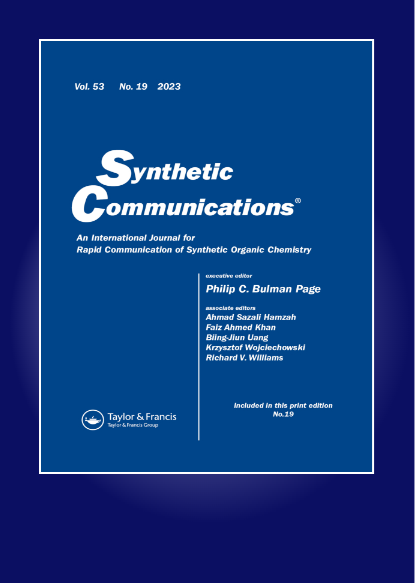Synthesis and anticancer evaluation of novel azoloquinolinyl phosphonates, 1,4,2-Diazaphospholes, 1,4,2-Oxazaphosphinines, and 1,4,2-Diazaphosphinines containing a 4-quinolinone ring: Cytotoxicity, apoptosis, cell cycle analysis, In silico ADMET, and molecular docking studies
IF 1.8
3区 化学
Q3 CHEMISTRY, ORGANIC
引用次数: 0
Abstract
One-pot synthetic strategy was designed for the synthesis of novel diethyl (pyrazolo- [4,3-c]quinolin-3-yl)phosphonates and diethyl (isoxazolo[4,5-c]quinolin-3-yl)phosphonate. The novel phosphorus heterocycles of types 1,4,2-diazaphospholes, 1,4,2-oxazaphosphinines and 1,4,2-diazaphosphinines containing 4-quinolinone ring were also achieved. The designed strategies depended on a three component reaction of 4-oxo-1,4-dihydroquinoline-3-carboxaldehyde (1) with a series of bi-nucleophilic nitrogen reagents in the presence of diethyl phosphite under solvent-free and catalyst-free conditions. This newly developed approach helped to synthesize new ten organophosphorus compounds with good yields. The IR, MS and NMR spectroscopic tools were used to characterize the isolated compounds, and their formation mechanisms were discussed. All synthesized compounds were evaluated for their in vitro cytotoxicity against A549, MDA-MB-231 and HeLa cell lines. Compounds 10 and 11 exhibited the most potent cytotoxicity, in comparison with doxorubicin. Furthermore, these two compounds significantly induced early apoptosis and reducing cell viability in the studied tumor cells. Additionally, both compounds 10 and 11 demonstrated promising ability to arrest the cell cycle at the S and G2 phases. In silico ADMET predictions indicated that compounds 10 and 11 possess higher predicted human intestinal absorption (∼89.6% vs. 51.85% for doxorubicin), absence of AMES mutagenicity, and lower predicted acute and chronic oral toxicities in rats. Potential hepatotoxicity and CYP enzyme inhibition were also observed. Molecular docking against EGFR-T790M/V948R revealed that both compound 10 and 11 exhibited a binding affinity of −8.4 and 8.9 kcal/mol, respectively. The interactions of both compounds with key amino acid residues (e.g., LEU 718, VAL 726, ALA 743, MET 790, ASP 855) were consistent with their strong in vitro cytotoxic activity against A549 (EGFR-mutated) cells, supporting their potential as EGFR-targeted anticancer agents.
新型偶氮喹啉基膦酸盐、1,4,2-二氮喹啉孔、1,4,2-恶氮喹啉和1,4,2-含4-喹啉酮环的二氮喹啉的合成和抗癌评价:细胞毒性、凋亡、细胞周期分析、硅ADMET和分子对接研究
设计了一锅法合成新型(吡唑啉- [4,3-c]喹啉-3-基)膦酸二乙酯和(异恶唑啉[4,5-c]喹啉-3-基)膦酸二乙酯。还获得了1,4,2-二氮磷孔型、1,4,2-恶氮磷和含4-喹啉酮环的1,4,2-二氮磷的新型磷杂环。设计的策略依赖于在无溶剂和无催化剂的条件下,4-氧-1,4-二氢喹啉-3-甲醛(1)与一系列双亲核氮试剂在亚磷酸二乙酯存在下的三组分反应。这种新方法有助于合成新的十种有机磷化合物,收率高。利用红外光谱、质谱和核磁共振光谱对分离得到的化合物进行了表征,并对其形成机理进行了探讨。所有合成的化合物对A549、MDA-MB-231和HeLa细胞株的体外细胞毒性进行了评价。与阿霉素相比,化合物10和11表现出最强的细胞毒性。此外,这两种化合物显著诱导肿瘤细胞早期凋亡和降低细胞活力。此外,化合物10和11都显示出在S期和G2期阻止细胞周期的能力。ADMET预测表明,化合物10和11具有较高的预测人体肠道吸收(~ 89.6%,而阿霉素为51.85%),没有AMES诱变性,并且在大鼠中具有较低的预测急性和慢性口服毒性。潜在的肝毒性和CYP酶抑制也被观察到。与EGFR-T790M/V948R的分子对接表明,化合物10和11的结合亲和力分别为−8.4和8.9 kcal/mol。这两种化合物与关键氨基酸残基(如LEU 718, VAL 726, ALA 743, MET 790, ASP 855)的相互作用与它们对A549 (egfr突变)细胞的强体外细胞毒活性一致,支持它们作为egfr靶向抗癌药物的潜力。
本文章由计算机程序翻译,如有差异,请以英文原文为准。
求助全文
约1分钟内获得全文
求助全文
来源期刊

Synthetic Communications
化学-有机化学
CiteScore
4.40
自引率
4.80%
发文量
156
审稿时长
4.3 months
期刊介绍:
Synthetic Communications presents communications describing new methods, reagents, and other synthetic work pertaining to organic chemistry with sufficient experimental detail to permit reported reactions to be repeated by a chemist reasonably skilled in the art. In addition, the Journal features short, focused review articles discussing topics within its remit of synthetic organic chemistry.
 求助内容:
求助内容: 应助结果提醒方式:
应助结果提醒方式:


